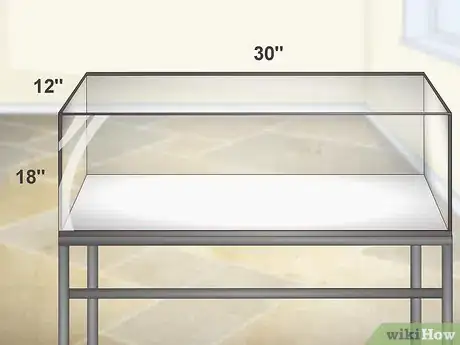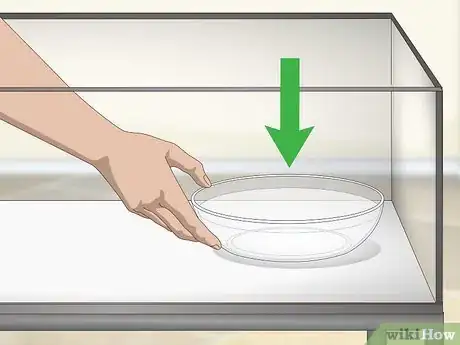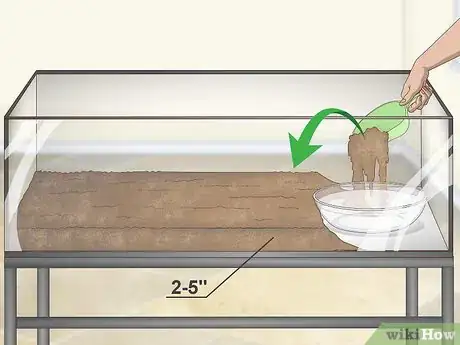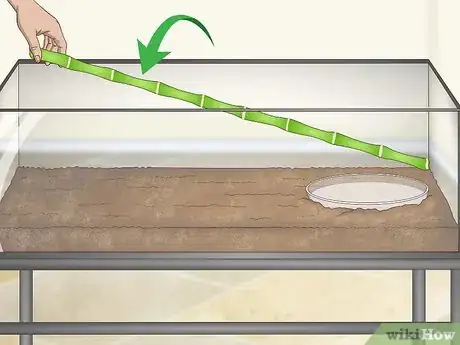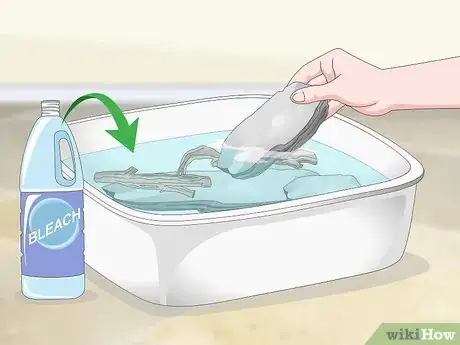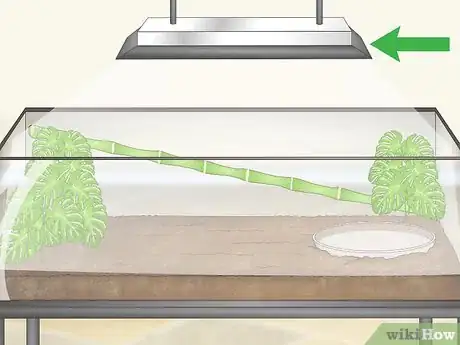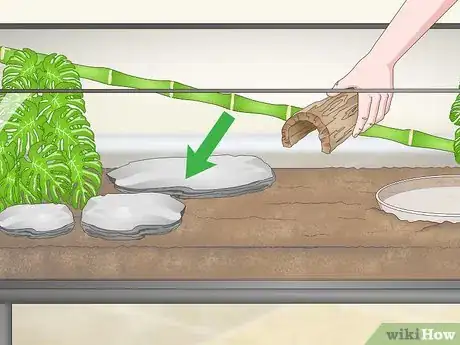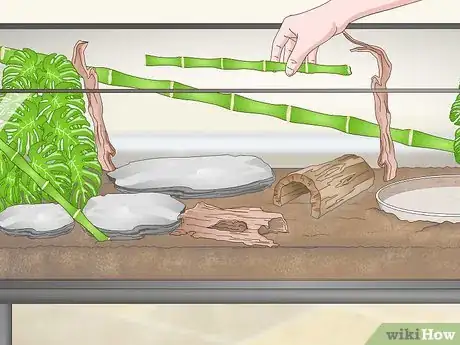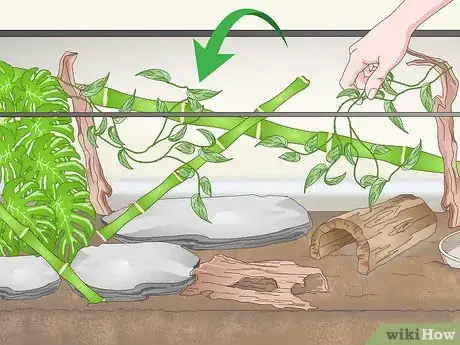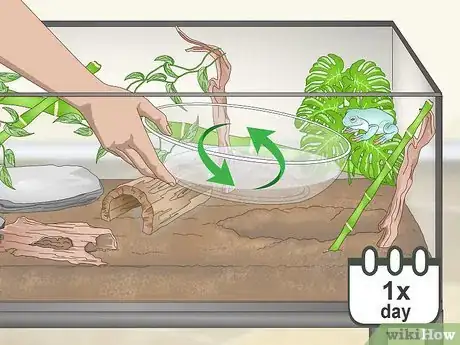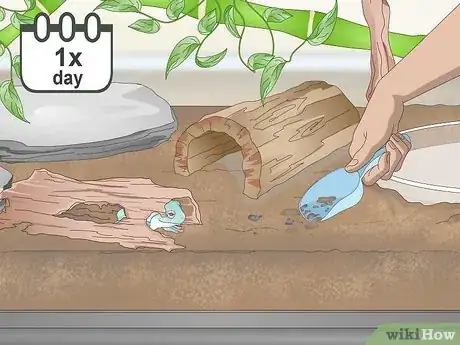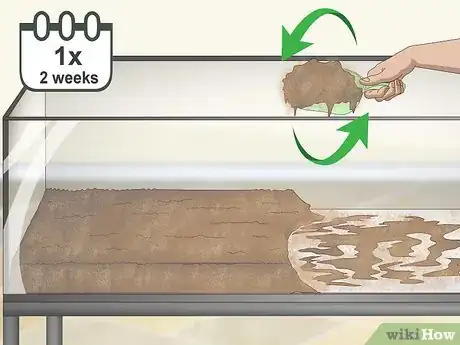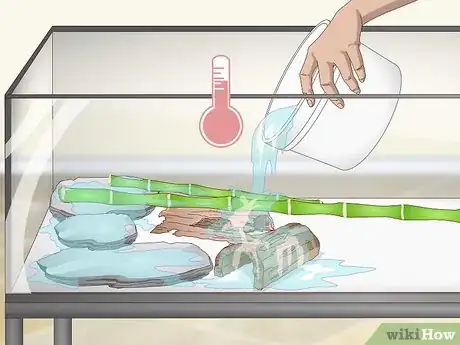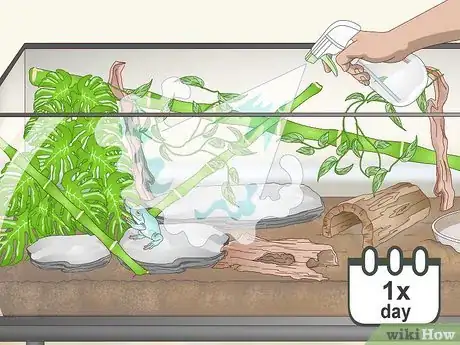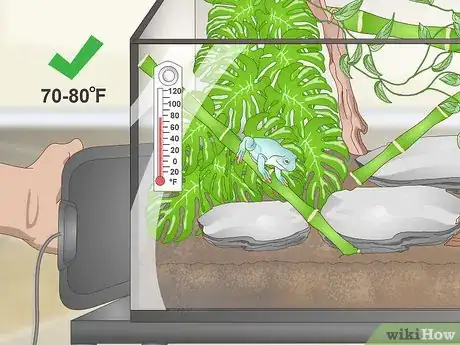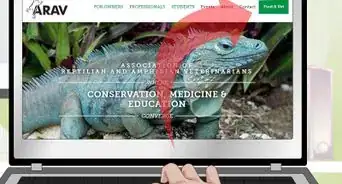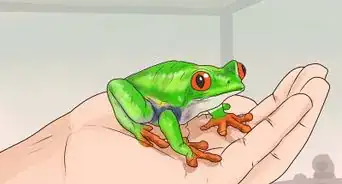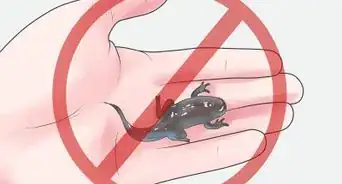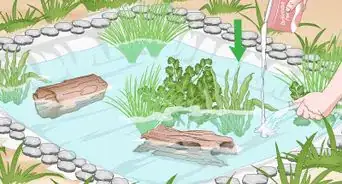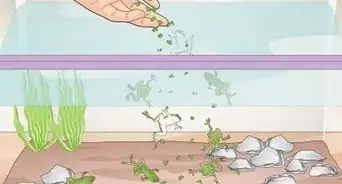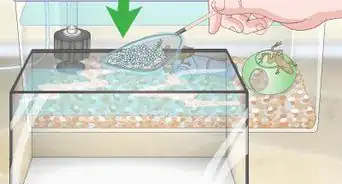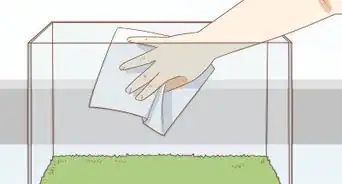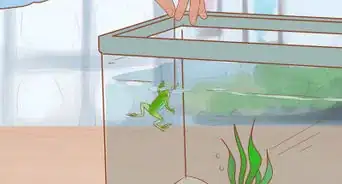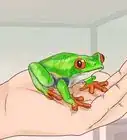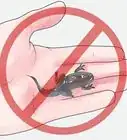This article was co-authored by wikiHow staff writer, Jennifer Mueller, JD. Jennifer Mueller is a wikiHow Content Creator. She specializes in reviewing, fact-checking, and evaluating wikiHow's content to ensure thoroughness and accuracy. Jennifer holds a JD from Indiana University Maurer School of Law in 2006.
This article has been viewed 42,402 times.
Learn more...
With their permanently smiling faces and chubby bodies, White's tree frogs are popular choices among people who decide they want pet frogs. They are hardy, easy to tame, and will eat almost anything. Their habitats are also relatively low maintenance, as far as amphibians go, without the strict heat and humidity requirements of some more exotic species.[1]
Steps
Setting Up the Enclosure
-
1Buy an aquarium that measures at least 30 by 12 by 18 inches (76 × 30 × 46 cm). This size aquarium would hold around 29 gallons (110 L) of water. You can find aquariums of this size in pet stores or online. This size is suitable for 2 to 4 adult White's tree frogs. Make sure the aquarium has a lid so your frogs won't jump out.[2]
- If you get juveniles, they can be housed in smaller enclosures. However, keep in mind that you'll have to buy a larger one as they grow.
- More space is always preferable. As their name suggests, White's tree frogs like to climb and sleep on higher branches, so look for the tallest aquarium you can find.[3]
-
2Set a water bowl in the bottom of the aquarium. Your White's tree frogs will need a water bowl in case they want to take a swim. You can buy water bowels suitable for terrariums online or at any pet store. Many of them have a very natural look that will fit right in with your enclosure. Look for one big enough to cover about 20 to 30 percent of the floor space of your terrarium. [4]
- You can also design a water feature in the bottom of the enclosure. If you do this, you will also need 1 to 2 inches (2.5 to 5.1 cm) of gravel on the very bottom of the enclosure to act as a drainage layer. Use cork along the sides of the water feature to separate the water from the rest of the enclosure.
- Keep in mind that while designing a water feature rather than using a water bowl may look more natural, it will be much more difficult to clean and change the water.
Advertisement -
3Line the bottom of the aquarium with 2 to 5 inches (5.1 to 12.7 cm) of substrate. Finely ground coconut fiber makes an excellent substrate for White's tree frog enclosures, and can be found in most pet stores. Topsoil or potting soil is also appropriate, as long as it has small particles.[5]
- Surround the water bowl with substrate so that your frogs won't be able to tip the bowl over if they step on the side.
- Specialty substrates designed for dart frog terrariums are also appropriate for White's tree frogs, but may be more expensive.
- Avoid substrates with large particles, such as aquarium gravel. These can lead to intestinal impaction.
Tip: White's tree frogs use their front feet to shove food into their mouths and can be messy eaters. A finely ground substrate ensures their intestines won't get impacted if some of the substrate ends up in their mouths.
-
4Place large sticks or bamboo poles diagonally from top to bottom corner. Choose thick branches or bamboo poles with a diameter of 1.5 to 2 inches (3.8 to 5.1 cm) to support the weight of adult White's tree frogs. You can buy suitable poles and branches at pet stores and terrarium supply stores or online.[6]
- Arrange these larger sticks so that they are going diagonally across the enclosure from a bottom corner to a top corner on the opposite side.
- It's a good idea to bring along a tape measure when you shop for these so you can make sure they're the right size for your enclosure. Before you go shopping, measure the distance from the places you want the poles to go.
Tip: Buy thick branches or poles that are specifically designed for use in a terrarium, rather than going out in the woods to find something you can use. You can be assured of the strength, durability, and quality of these items.
Designing a Natural Environment
-
1Sterilize any rocks or branches you gather from outside. Soak your items in a half-water/half-bleach mixture overnight. The next day, take them out and rinse them thoroughly, then soak them in dechlorinated or spring water the following night. After you take them out of the water, make sure they don't smell like bleach. If they do, rinse them with hot water and soak them again.[7]
- While it can be fun to go out in the woods yourself and hunt for rocks, branches, and other natural items that you can put in your frog's enclosure, these items may be carrying bacteria, molds, or fungi that are dangerous to your frog's health.
Tip: Branches and rocks that you buy in a pet store are pre-cleaned, and don't need to be sterilized. However, you should still wash them with hot water before you add them to your frog's enclosure.
-
2Use large-leaf terrarium plants to mimic the frog's natural habitat. Adding plants helps the enclosure simulate your frog's natural habitat and also gives it places to hide. Terrarium plants such as Monstera and Philodendron can handle your frog's weight without breaking. Either fake plants or real plants are fine.[8]
- If you're using live plants, give them a couple of weeks to establish themselves before you introduce your frogs. Otherwise, they will get trampled.
-
3Provide a light for live plants. White's tree frogs don't really need specific lighting conditions like some amphibians do. In fact, too much light can have a negative impact on their health by making the terrarium to hot and dry. If you're growing live plants in the terrarium, use a fluorescent plant light that doesn't give off a lot of heat.[9]
- You can also use a standard fluorescent aquarium light. These should be available at the same place where you bought your aquarium, and are designed specifically to fit your aquarium.
-
4Add rocks and cork bark to create perches and hides at ground level. Various size rocks, cork bark, and other features add elements of interest to the habitat and also make it look more natural. There are plenty of options available online or at pet stores and terrarium supply stores. You can also search outside for interesting rocks and other features.[10]
- Your White's tree frog will appreciate places to perch as well as places to hide when it's down on the floor. Older frogs, in particular, spend more of their time down in the substrate than climbing on the branches.
-
5Cross the bamboo poles with branches and driftwood. Apart from the main bamboo poles where your frog will likely spend much of its time, smaller branches and driftwood allow it to easily move around the enclosure.[11]
- Make sure anything that is leaning up in the enclosure is strong enough to support your frog's weight. If you have more than one frog, there may be multiple frogs crowding a single branch. Small twigs could snap under their weight.
-
6Drape foliage over high branches to create a high hiding place. Use fake or living vines and leaves to create places for your frog to hide when it's high up in the branches or on the bamboo poles. White's tree frogs also like to hide in the crooks of crossed branches, so you can cover some of those spots as well.[12]
- If you have living vines growing in the terrarium, you can use smaller twigs to train the vines so they'll twist up in a certain direction as they grow. The vines will also make the smaller twigs stronger and better able to handle the frog's weight.
Maintaining Your Frog's Habitat
-
1Change the water daily to keep it clean. Empty the water dish daily and fill it with lukewarm dechlorinated or spring water. If the bowl is grimy, clean it with hot water. Do not use soap or household cleaners on anything you put in your frog's enclosure.[13]
- If you have a larger terrarium with a built-in water feature, you may want to install a water filtration system similar to those in aquariums. While this will keep the water clean on a daily basis, you still need to change the water at least once a week even if you have a built-in filter.
-
2Spot-clean the habitat at least once a day. Check in on your frogs and remove any feces, soiled substrate, and dead or uneaten food items. Look for mold and remove any you see – it can cause your frog to have respiratory problems.[14]
- If you have 4 or more frogs, you may want to do this twice a day. You should also spot-clean the enclosure after feeding your frogs.
-
3Replace the substrate every other week. Move your frog to a temporary enclosure and scoop out all of the substrate in the enclosure. Wipe down the floor with dechlorinated water and spread new substrate at the same thickness as the old substrate.[15]
- If you have growing plants, you won't be able to remove all of the substrate. Carefully turn the soil around the plants, being careful not to damage the plants' root structures.
Tip: You can use a plastic container with a lid as a temporary enclosure for your frog while you replace the substrate. Line the bottom with damp paper towels and poke holes in the lid so your frog has adequate ventilation.
-
4Clean the enclosure and furnishings with hot water. When you replace the substrate, take the time to clean the enclosure before putting the substrate, rocks, branches, and other furnishings back. After cleaning them, make sure they're relatively dry before you return them to the enclosure.[16]
- Inspect your branches, rocks, and other features for mold or any cracks that could hurt your frog. If a feature is damaged, don't return it to your frog's enclosure.
-
5Mist the entire enclosure once a day. White's tree frogs don't have the humidity requirements many amphibians do and actually prefer a relatively dry environment. Misting the enclosure once a day with a spray bottle typically provides enough moisture.[17]
- Ideally, you want humidity to vary from 30 to 70 percent throughout different areas of the enclosure.[18]
- Avoid saturating the substrate. This encourages the growth of mold and fungi, which can cause respiratory problems in White's tree frogs.
Tip: If your otherwise-healthy White's tree frog turns brown, this is a signal that its enclosure is too damp.
-
6Maintain a daytime temperature between 70 to 80 °F (21 to 27 °C). White's tree frogs can tolerate a wide range of temperatures. They tend to be most comfortable at the same temperatures most people consider comfortable, so additional heating shouldn't be necessary if you keep the enclosure indoors and away from drafts.[19]
- For short periods of time they will be fine in temperatures above 90 °F (32 °C) or below 50 °F (10 °C).
- If it does get too cold, you can add a reptile heating pad to the side of the enclosure. Use a thermostat to control it and make sure it doesn't make the enclosure too hot.
Tip: If you keep your frog's enclosure at 80 °F (27 °C) or higher, you may need to feed it more often.
Community Q&A
-
QuestionCan I use well water for my frog?
 Community AnswerYes, well water should be fine as long as it's clean and you de-chlorinate the water.
Community AnswerYes, well water should be fine as long as it's clean and you de-chlorinate the water. -
QuestionHow often should I do a full terrarium clean?
 Community AnswerYou should clean it about every 2 weeks, or whenever it gets dirty.
Community AnswerYou should clean it about every 2 weeks, or whenever it gets dirty. -
QuestionHow big do they get, and what size tank would I need?
 Community AnswerWhite's tree frogs are great climbers, so they require a terrarium taller than it is wide. There are two styles of terrariums from which you can choose: an arboreal tank and a terrestrial tank. Arboreal terrariums are about 2 feet high, and they provide more room for climbing, which is beneficial because White's tree frogs spend a good deal of time high in the branches. Terrestrial terrariums aren't generally as high, but they do have wider bases. Regardless of which style you choose, the smallest enclosure should be at least 20 gallons for one frog. Two or more frogs need a larger terrarium.
Community AnswerWhite's tree frogs are great climbers, so they require a terrarium taller than it is wide. There are two styles of terrariums from which you can choose: an arboreal tank and a terrestrial tank. Arboreal terrariums are about 2 feet high, and they provide more room for climbing, which is beneficial because White's tree frogs spend a good deal of time high in the branches. Terrestrial terrariums aren't generally as high, but they do have wider bases. Regardless of which style you choose, the smallest enclosure should be at least 20 gallons for one frog. Two or more frogs need a larger terrarium.
Things You'll Need
- 30 × 12 × 18 in (76 × 30 × 46 cm) aquarium with lid
- Bowl for water
- Finely ground coconut fiber or topsoil
- Dechlorinated tap water or bottled spring water
- Bamboo poles
- Plants (fake or real)
- Branches, rocks, cork bark, or driftwood
- Spray bottle or mister
- Fluorescent lighting for plants
References
- ↑ http://www.reptilesmagazine.com/Frogs-Amphibians/Whites-Treefrog-Enclosure-Information-and-Care/
- ↑ http://amphibiancare.com/2005/06/24/whites-tree-frog/
- ↑ http://www.reptilesmagazine.com/Frogs-Amphibians/Whites-Treefrog-Enclosure-Information-and-Care/
- ↑ http://www.reptilesmagazine.com/Frogs-Amphibians/Whites-Treefrog-Enclosure-Information-and-Care/
- ↑ http://www.reptilesmagazine.com/Frogs-Amphibians/Whites-Treefrog-Enclosure-Information-and-Care/
- ↑ http://amphibiancare.com/2005/06/24/whites-tree-frog/
- ↑ http://www.anapsid.org/greentreefrog.html
- ↑ http://www.reptilesmagazine.com/Frogs-Amphibians/Whites-Treefrog-Enclosure-Information-and-Care/
- ↑ http://www.reptilesmagazine.com/Care-Sheets/Whites-Treefrog-Care-Sheet/
- ↑ http://amphibiancare.com/2005/06/24/whites-tree-frog/
- ↑ http://amphibiancare.com/2005/06/24/whites-tree-frog/
- ↑ http://amphibiancare.com/2005/06/24/whites-tree-frog/
- ↑ http://www.reptilesmagazine.com/Frogs-Amphibians/Whites-Treefrog-Enclosure-Information-and-Care/
- ↑ http://www.reptilesmagazine.com/Frogs-Amphibians/Whites-Treefrog-Enclosure-Information-and-Care/
- ↑ http://www.reptilesmagazine.com/Frogs-Amphibians/Whites-Treefrog-Enclosure-Information-and-Care/
- ↑ http://www.anapsid.org/greentreefrog.html
- ↑ http://www.reptilesmagazine.com/Frogs-Amphibians/Whites-Treefrog-Enclosure-Information-and-Care/
- ↑ http://amphibiancare.com/2005/06/24/whites-tree-frog/
- ↑ http://www.reptilesmagazine.com/Frogs-Amphibians/Whites-Treefrog-Enclosure-Information-and-Care/
- ↑ http://www.reptilesmagazine.com/Frogs-Amphibians/Whites-Treefrog-Enclosure-Information-and-Care/
- ↑ http://www.reptilesmagazine.com/Frogs-Amphibians/Whites-Treefrog-Enclosure-Information-and-Care/
